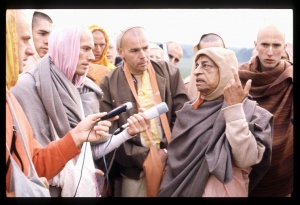CC Madhya 9.310: Difference between revisions
m (1 revision(s)) |
(Vanibot #0054 edit - transform synonyms into clickable links, which search similar occurrences) |
||
| (One intermediate revision by one other user not shown) | |||
| Line 1: | Line 1: | ||
{{ | [[Category:Sri Caitanya-caritamrta - Madhya-lila Chapter 09|C310]] | ||
<div style="float:left">'''[[Sri Caitanya-caritamrta|Śrī Caitanya-caritāmṛta]] - [[CC Madhya|Madhya-līlā]] - [[CC Madhya 9|Chapter 9: Lord Śrī Caitanya Mahāprabhu's Travels to the Holy Places]]'''</div> | |||
<div style="float:right">[[File:Go-previous.png|link=CC Madhya 9.309|Madhya-līlā 9.309]] '''[[CC Madhya 9.309|Madhya-līlā 9.309]] - [[CC Madhya 9.311|Madhya-līlā 9.311]]''' [[File:Go-next.png|link=CC Madhya 9.311|Madhya-līlā 9.311]]</div> | |||
{{CompareVersions|CC|Madhya 9.310|CC 1975|CC 1996}} | |||
{{RandomImage}} | |||
==== TEXT 310 ==== | ==== TEXT 310 ==== | ||
<div | <div class="verse"> | ||
tāpī snāna kari’ āilā māhiṣmatī-pure | :tāpī snāna kari’ āilā māhiṣmatī-pure | ||
nānā tīrtha dekhi tāhāṅ narmadāra tīre | :nānā tīrtha dekhi tāhāṅ narmadāra tīre | ||
</div> | </div> | ||
| Line 12: | Line 16: | ||
==== SYNONYMS ==== | ==== SYNONYMS ==== | ||
<div | <div class="synonyms"> | ||
''[//vanipedia.org/wiki/Special:VaniSearch?s=tāpī&tab=syno_o&ds=1 tāpī]'' — in the Tāpī River; ''[//vanipedia.org/wiki/Special:VaniSearch?s=snāna&tab=syno_o&ds=1 snāna] [//vanipedia.org/wiki/Special:VaniSearch?s=kari’&tab=syno_o&ds=1 kari’]'' — taking a bath; ''[//vanipedia.org/wiki/Special:VaniSearch?s=āilā&tab=syno_o&ds=1 āilā]'' — arrived; ''[//vanipedia.org/wiki/Special:VaniSearch?s=māhiṣmatī&tab=syno_o&ds=1 māhiṣmatī]-[//vanipedia.org/wiki/Special:VaniSearch?s=pure&tab=syno_o&ds=1 pure]'' — at Māhiṣmatī-pura; ''[//vanipedia.org/wiki/Special:VaniSearch?s=nānā&tab=syno_o&ds=1 nānā] [//vanipedia.org/wiki/Special:VaniSearch?s=tīrtha&tab=syno_o&ds=1 tīrtha]'' — many holy places; ''[//vanipedia.org/wiki/Special:VaniSearch?s=dekhi&tab=syno_o&ds=1 dekhi]'' — seeing; ''[//vanipedia.org/wiki/Special:VaniSearch?s=tāhāṅ&tab=syno_o&ds=1 tāhāṅ]'' — there; ''[//vanipedia.org/wiki/Special:VaniSearch?s=narmadāra&tab=syno_o&ds=1 narmadāra] [//vanipedia.org/wiki/Special:VaniSearch?s=tīre&tab=syno_o&ds=1 tīre]'' — on the bank of the river Narmadā. | |||
</div> | </div> | ||
| Line 19: | Line 23: | ||
==== TRANSLATION ==== | ==== TRANSLATION ==== | ||
<div | <div class="translation"> | ||
Śrī Caitanya Mahāprabhu next arrived at the banks of the river Tāpī. After bathing there, He went to Māhiṣmatī-pura. While there, He saw many holy places on the banks of the river Narmadā. | Śrī Caitanya Mahāprabhu next arrived at the banks of the river Tāpī. After bathing there, He went to Māhiṣmatī-pura. While there, He saw many holy places on the banks of the river Narmadā. | ||
</div> | </div> | ||
| Line 26: | Line 30: | ||
==== PURPORT ==== | ==== PURPORT ==== | ||
<div | <div class="purport"> | ||
The river Tāpī is also known as Tāpti. The river’s source is a mountain called Multāi, and the river flows westward through the state of Saurāṣṭra and into the Arabian Sea. | The river Tāpī is also known as Tāpti. The river’s source is a mountain called Multāi, and the river flows westward through the state of Saurāṣṭra and into the Arabian Sea. | ||
Māhiṣmatī-pura (Maheshwar) is mentioned in Mahābhārata in connection with Sahadeva’s victory. Sahadeva, the youngest brother of the Pāṇḍavas, conquered that part of the country. As stated in the Mahābhārata: | Māhiṣmatī-pura (Maheshwar) is mentioned in ''Mahābhārata'' in connection with Sahadeva’s victory. Sahadeva, the youngest brother of the Pāṇḍavas, conquered that part of the country. As stated in the ''Mahābhārata'': | ||
:tato ratnāny upādāya purīṁ māhiṣmatīṁ yayau | :''tato ratnāny upādāya purīṁ māhiṣmatīṁ yayau'' | ||
:tatra nīlena rājñā sa cakre yuddhaṁ nararṣabhaḥ | :''tatra nīlena rājñā sa cakre yuddhaṁ nararṣabhaḥ'' | ||
“After acquiring jewels, Sahadeva went to the city of Māhiṣmatī, where he fought with a king called Nīla.” | “After acquiring jewels, Sahadeva went to the city of Māhiṣmatī, where he fought with a king called Nīla.” | ||
</div> | </div> | ||
__NOTOC__ | |||
<div style="float:right; clear:both;">[[File:Go-previous.png|link=CC Madhya 9.309|Madhya-līlā 9.309]] '''[[CC Madhya 9.309|Madhya-līlā 9.309]] - [[CC Madhya 9.311|Madhya-līlā 9.311]]''' [[File:Go-next.png|link=CC Madhya 9.311|Madhya-līlā 9.311]]</div> | |||
__NOTOC__ | |||
__NOEDITSECTION__ | |||
Latest revision as of 00:08, 20 February 2024

A.C. Bhaktivedanta Swami Prabhupada
TEXT 310
- tāpī snāna kari’ āilā māhiṣmatī-pure
- nānā tīrtha dekhi tāhāṅ narmadāra tīre
SYNONYMS
tāpī — in the Tāpī River; snāna kari’ — taking a bath; āilā — arrived; māhiṣmatī-pure — at Māhiṣmatī-pura; nānā tīrtha — many holy places; dekhi — seeing; tāhāṅ — there; narmadāra tīre — on the bank of the river Narmadā.
TRANSLATION
Śrī Caitanya Mahāprabhu next arrived at the banks of the river Tāpī. After bathing there, He went to Māhiṣmatī-pura. While there, He saw many holy places on the banks of the river Narmadā.
PURPORT
The river Tāpī is also known as Tāpti. The river’s source is a mountain called Multāi, and the river flows westward through the state of Saurāṣṭra and into the Arabian Sea.
Māhiṣmatī-pura (Maheshwar) is mentioned in Mahābhārata in connection with Sahadeva’s victory. Sahadeva, the youngest brother of the Pāṇḍavas, conquered that part of the country. As stated in the Mahābhārata:
- tato ratnāny upādāya purīṁ māhiṣmatīṁ yayau
- tatra nīlena rājñā sa cakre yuddhaṁ nararṣabhaḥ
“After acquiring jewels, Sahadeva went to the city of Māhiṣmatī, where he fought with a king called Nīla.”